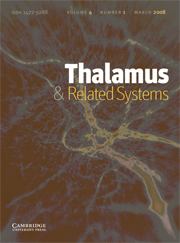Article contents
The role of the thalamic reticular nucleus in visual processing
Published online by Cambridge University Press: 15 August 2007
Abstract
The thalamic reticular nucleus (TRN) is an integral part of the thalamic circuitry that mediates the transfer of information to the cortex in the major sensory pathways. Here, we consider its role in visual processing. The TRN provides an inhibitory, GABA-mediated input to relay cells in the thalamus. A key feature of TRN cells is that, because of the extent of their dendritic arborization, they have the capacity to collate visual information from the ascending relay cells and feedback axons from the cortex over a wide retinotopic area, but they feed it back to the thalamus in a narrowly focused retinotopic projection. The corticofugal input to TRN cells is mediated by a higher proportion of AMPA receptors than that to thalamic relay cells and produces sharp EPSCs. We suggest that this might bias the TRN cells to precisely timed, feature-driven feedback from the visual cortex. TRN cells are particularly well driven by either phasic or moving stimuli, so the influence on relay cells provides a strong, transient, inhibitory modulation of relay-cell activity. This might aid image segmentation and highlight responses to moving contours. Although the role of the TRN has been especially linked to selective attention, we suggest that, for vision, its function is linked more closely to the operation of the thalamocortico-thalamic loop as a whole, and that retinotopically selective attentional effects draw on the interaction with the cortical mechanism that influences TRN and relay-cell circuitry equally.
Information
- Type
- Original Articles
- Information
- Copyright
- Copyright © Cambridge University Press 2007
References
REFERENCES
- 3
- Cited by

